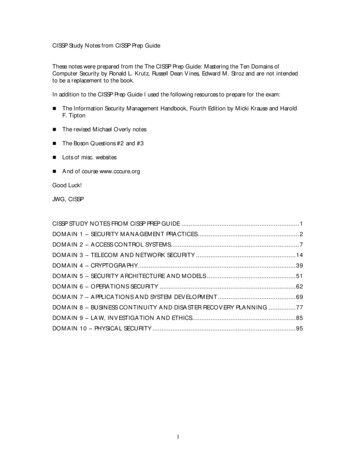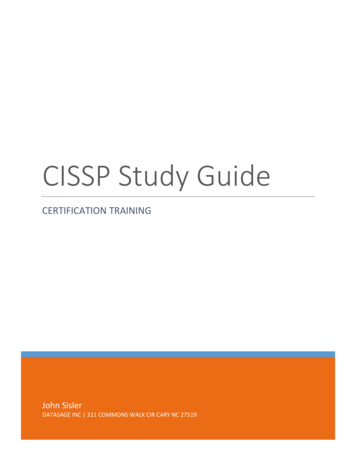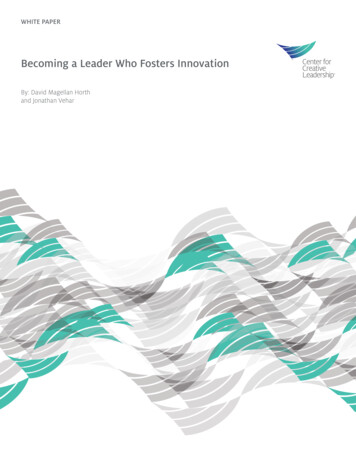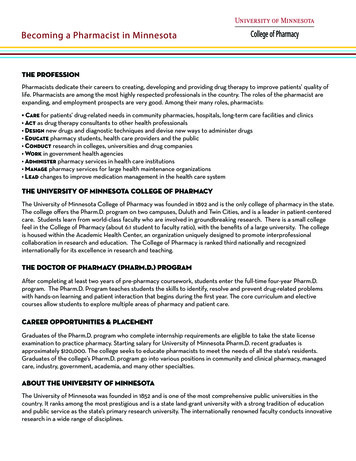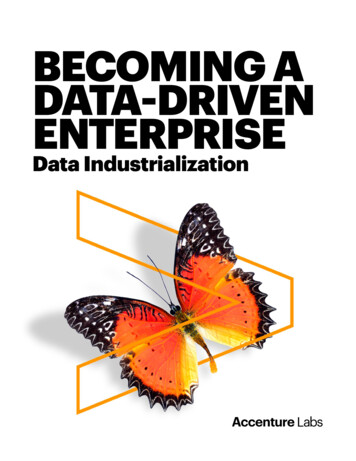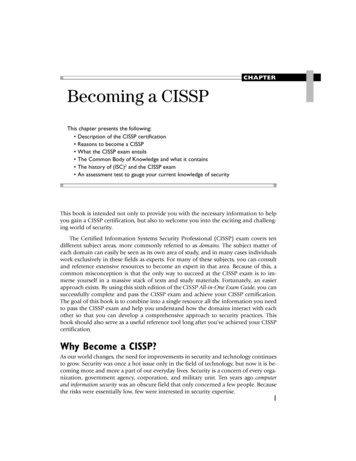
Transcription
All-in-1 /CISSP Exam Guide, Sixth Edition / Harris / 174-9CHAPTERBecoming a CISSP1This chapter presents the following: Description of the CISSP certification Reasons to become a CISSP What the CISSP exam entails The Common Body of Knowledge and what it contains The history of (ISC)2 and the CISSP exam An assessment test to gauge your current knowledge of securityThis book is intended not only to provide you with the necessary information to helpyou gain a CISSP certification, but also to welcome you into the exciting and challenging world of security.The Certified Information Systems Security Professional (CISSP) exam covers tendifferent subject areas, more commonly referred to as domains. The subject matter ofeach domain can easily be seen as its own area of study, and in many cases individualswork exclusively in these fields as experts. For many of these subjects, you can consultand reference extensive resources to become an expert in that area. Because of this, acommon misconception is that the only way to succeed at the CISSP exam is to immerse yourself in a massive stack of texts and study materials. Fortunately, an easierapproach exists. By using this sixth edition of the CISSP All-in-One Exam Guide, you cansuccessfully complete and pass the CISSP exam and achieve your CISSP certification.The goal of this book is to combine into a single resource all the information you needto pass the CISSP exam and help you understand how the domains interact with eachother so that you can develop a comprehensive approach to security practices. Thisbook should also serve as a useful reference tool long after you’ve achieved your CISSPcertification.Why Become a CISSP?As our world changes, the need for improvements in security and technology continuesto grow. Security was once a hot issue only in the field of technology, but now it is becoming more and more a part of our everyday lives. Security is a concern of every organization, government agency, corporation, and military unit. Ten years ago computerand information security was an obscure field that only concerned a few people. Becausethe risks were essentially low, few were interested in security expertise.1ch01.indd 19/22/12 4:14 PM
All-in-1 /CISSP Exam Guide, Sixth Edition / Harris / 174-9CISSP All-in-One Exam Guide2Things have changed, however, and today corporations and other organizations aredesperate to recruit talented and experienced security professionals to help protect theresources they depend on to run their businesses and to remain competitive. With aCISSP certification, you will be seen as a security professional of proven ability who hassuccessfully met a predefined standard of knowledge and experience that is well understood and respected throughout the industry. By keeping this certification current, youwill demonstrate your dedication to staying abreast of security developments.Consider the reasons for attaining a CISSP certification: To meet the growing demand and to thrive in an ever-expanding field To broaden your current knowledge of security concepts and practices To bring security expertise to your current occupation To become more marketable in a competitive workforce To show a dedication to the security discipline To increase your salary and be eligible for more employment opportunitiesThe CISSP certification helps companies identify which individuals have the ability,knowledge, and experience necessary to implement solid security practices; performrisk analysis; identify necessary countermeasures; and help the organization as a wholeprotect its facility, network, systems, and information. The CISSP certification alsoshows potential employers you have achieved a level of proficiency and expertise inskill sets and knowledge required by the security industry. The increasing importanceplaced on security in corporate success will only continue in the future, leading to evengreater demands for highly skilled security professionals. The CISSP certification showsthat a respected third-party organization has recognized an individual’s technical andtheoretical knowledge and expertise, and distinguishes that individual from those wholack this level of knowledge.Understanding and implementing security practices is an essential part of being agood network administrator, programmer, or engineer. Job descriptions that do notspecifically target security professionals still often require that a potential candidatehave a good understanding of security concepts as well as how to implement them. Dueto staff size and budget restraints, many organizations can’t afford separate networkand security staffs. But they still believe security is vital to their organization. Thus, theyoften try to combine knowledge of technology and security into a single role. With aCISSP designation, you can put yourself head and shoulders above other individuals inthis regard.The CISSP ExamBecause the CISSP exam covers the ten domains making up the CISSP Common Bodyof Knowledge (CBK), it is often described as being “an inch deep and a mile wide,” areference to the fact that many questions on the exam are not very detailed and do notrequire you to be an expert in every subject. However, the questions do require you tobe familiar with many different security subjects.ch01.indd 29/22/12 4:14 PM
All-in-1 /CISSP Exam Guide, Sixth Edition / Harris / 174-9Chapter 1: Becoming a CISSP3The CISSP exam comprises 250 multiple-choice questions, and you have up to sixhours to complete it. The questions are pulled from a much larger question bank toensure the exam is as unique as possible for each entrant. In addition, the test bankconstantly changes and evolves to more accurately reflect the real world of security. Theexam questions are continually rotated and replaced in the bank as necessary. Eachquestion has four answer choices, only one of which is correct. Only 225 questions aregraded, while 25 are used for research purposes. The 25 research questions are integrated into the exam, so you won’t know which go toward your final grade. To pass theexam, you need a minimum raw score of 700 points out of 1,000. Questions areweighted based on their difficulty; not all questions are worth the same number ofpoints. The exam is not product- or vendor-oriented, meaning no questions will bespecific to certain products or vendors (for instance, Windows, Unix, or Cisco). Instead,you will be tested on the security models and methodologies used by these types ofsystems.(ISC)2, which stands for International Information Systems Security CertificationConsortium, has also added scenario-based questions to the CISSP exam. These questions present a short scenario to the test taker rather than asking the test taker to identify terms and/or concepts. The goal of the scenario-based questions is to ensure thattest takers not only know and understand the concepts within the CBK, but also canapply this knowledge to real-life situations. This is more practical because in the realworld, you won’t be challenged by having someone asking you “What is the definitionof collusion?” You need to know how to detect and prevent collusion from taking place,in addition to knowing the definition of the term.After passing the exam, you will be asked to supply documentation, supported by asponsor, proving that you indeed have the type of experience required to obtain thiscertification. The sponsor must sign a document vouching for the security experienceyou are submitting. So, make sure you have this sponsor lined up prior to registeringfor the exam and providing payment. You don’t want to pay for and pass the exam, onlyto find you can’t find a sponsor for the final step needed to achieve your certification.The reason behind the sponsorship requirement is to ensure that those who achievethe certification have real-world experience to offer organizations. Book knowledge isextremely important for understanding theory, concepts, standards, and regulations,but it can never replace hands-on experience. Proving your practical experience supports the relevance of the certification.A small sample group of individuals selected at random will be audited after passing the exam. The audit consists mainly of individuals from (ISC)2 calling on the candidates’ sponsors and contacts to verify the test taker’s related experience.What makes this exam challenging is that most candidates, although they work inthe security field, are not necessarily familiar with all ten CBK domains. If a securityprofessional is considered an expert in vulnerability testing or application security, forexample, she may not be familiar with physical security, cryptography, or forensics.Thus, studying for this exam will broaden your knowledge of the security field.The exam questions address the ten CBK security domains, which are described inTable 1-1.ch01.indd 39/22/12 4:14 PM
All-in-1 /CISSP Exam Guide, Sixth Edition / Harris / 174-9CISSP All-in-One Exam Guide4DomainDescriptionAccess ControlThis domain examines mechanisms and methods used to enableadministrators and managers to control what subjects can access, theextent of their capabilities after authorization and authentication, andthe auditing and monitoring of these activities. Some of the topicscovered include Access control threats Identification and authentication technologies andtechniques Access control administration Single sign-on technologies Attack methodsTelecommunications andNetwork SecurityThis domain examines internal, external, public, and privatecommunication systems; networking structures; devices; protocols;and remote access and administration. Some of the topics coveredinclude OSI model and layers Local area network (LAN), metropolitan area network (MAN), andwide area network (WAN) technologies Internet, intranet, and extranet issues Virtual private networks (VPNs), firewalls, routers, switches, andrepeaters Network topologies and cabling Attack methodsInformation SecurityGovernance and RiskManagementThis domain examines the identification of company assets, theproper way to determine the necessary level of protection required,and what type of budget to develop for security implementations,with the goal of reducing threats and monetary loss. Some of thetopics covered include Data classification Policies, procedures, standards, and guidelines Risk assessment and management Personnel security, training, and awarenessSoftware DevelopmentSecurityThis domain examines secure software development approaches,application security, and software flaws. Some of the topics coveredinclude Data warehousing and data mining Various development practices and their risks Software components and vulnerabilities Malicious codeCryptographyThis domain examines cryptography techniques, approaches, andtechnologies. Some of the topics covered include Symmetric versus asymmetric algorithms and uses Public key infrastructure (PKI) and hashing functions Encryption protocols and implementation Attack methodsTable 1-1 Security Domains That Make Up the CISSP CBKch01.indd 49/22/12 4:14 PM
All-in-1 /CISSP Exam Guide, Sixth Edition / Harris / 174-9Chapter 1: Becoming a CISSP5DomainDescriptionSecurity Architectureand DesignThis domain examines ways that software should be designedsecurely. It also covers international security measurement standardsand their meaning for different types of platforms. Some of the topicscovered include Operating states, kernel functions, and memory mapping Security models, architectures, and evaluations Evaluation criteria: Trusted Computer Security Evaluation Criteria(TCSEC), Information Technology Security Evaluation Criteria(ITSEC), and Common Criteria Common flaws in applications and systems Certification and accreditationSecurity OperationsThis domain examines controls over personnel, hardware, systems,and auditing and monitoring techniques. It also covers possible abusechannels and how to recognize and address them. Some of the topicscovered include Administrative responsibilities pertaining to personnel and jobfunctions Maintenance concepts of antivirus, training, auditing, and resourceprotection activities Preventive, detective, corrective, and recovery controls Security and fault-tolerance technologiesBusiness Continuityand Disaster RecoveryPlanningThis domain examines the preservation of business activities whenfaced with disruptions or disasters. It involves the identificationof real risks, proper risk assessment, and countermeasureimplementation. Some of the topics covered include Business resource identification and value assignment Business impact analysis and prediction of possible losses Unit priorities and crisis management Plan development, implementation, and maintenanceLegal, Regulations,Investigations, andComplianceThis domain examines computer crimes, laws, and regulations. Itincludes techniques for investigating a crime, gathering evidence, andhandling procedures. It also covers how to develop and implement anincident-handling program. Some of the topics covered include Types of laws, regulations, and crimes Licensing and software piracy Export and import laws and issues Evidence types and admissibility into court Incident handling ForensicsTable 1-1 Security Domains That Make Up the CISSP CBK (continued)ch01.indd 59/22/12 4:14 PM
All-in-1 /CISSP Exam Guide, Sixth Edition / Harris / 174-9CISSP All-in-One Exam Guide6DomainDescriptionPhysical (Environmental)SecurityThis domain examines threats, risks, and countermeasures to protectfacilities, hardware, data, media, and personnel. This involves facilityselection, authorized entry methods, and environmental and safetyprocedures. Some of the topics covered include Restricted areas, authorization methods, and controls Motion detectors, sensors, and alarms Intrusion detection Fire detection, prevention, and suppression Fencing, security guards, and security badge typesTable 1-1 Sec
Table 1-1 Security Domains That Make Up the CISSP CBK cch01.indd 4h01.indd 4 99/22/12 4:14 PM/22/12 4:14 PM. Chapter 1: Becoming a CISSP 5 All-in-1 /CISSP Exam Guide, Sixth Edition / Harris / 174-9 Domain Description Security Architecture and Design This domain examines ways that software should be designed securely. It also covers international security measurement standards and their
